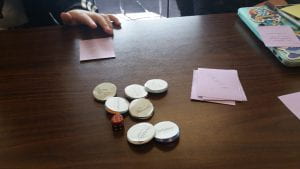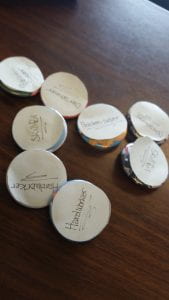You’re trying to get a promotion at work and compete with your coworkers to see who gets promoted first. During your 9 AM-5 PM shift, you try to make a lasting impression with your boss. The game ends when everyone reaches the 8-hour mark, and the player with the most points wins.
Materials:
- Index cards (or small sheets of paper)
- Button pins
- Writing utensil
- D6
Rules:
- Each index card represents a player’s time card.
- Each turn, the player rolls the D6. The number rolled determines how long it took to complete a task. Each number on the die constitutes the number of half-hours the task took to complete.
- Before the turn ends, the user draws a chance card*. Chance cards can grant the user bonus points, add time to the user’s task, or give no additional effects depending on the outcome.
- If the user assists another player, the user gains a token, which can be pinned to their clothing (optional).
- Players can steal tokens from others or take from the pile.
- Once a player hits the 8-hour mark, they are not allowed to take any further turns. Those remaining in the game are not allowed to steal tokens from these players.
*If you run out of chance cards, reshuffle the deck.



Artist Statement
In the beginning stages, I was a little confused and had trouble grasping a clear concept. I understood the definition, in words, of appropriation, but struggled trying to translate it into a playable game. I was too caught up on aesthetics and didn’t pay enough attention to the meaning of the objects I selected so that I could manipulate them in such a way. Luckily, this is where playtesting comes in, and I am able to make changes based on feedback from others.
In the first iteration of this game, the objective wasn’t very clear, as I was a little unsure of what exactly I wanted to appropriate in order to create this game. Initially, the goal was to finish all of your tasks without going over the allotted time. While this was an okay objective to start out with, there wasn’t much context or motivation to back up the original objective. After playtesting the first iteration and taking feedback into consideration, I was able to recreate a better idea.
After learning about the Dada movements and having prior knowledge of Fluxus and the idea of happenings, I came to appreciate the idea of an object being used in a new way while still being able to portray and capture its original meaning. In the beginning, it was a little difficult for me to grasp this concept, as I was so set on creating a specific game with specific aesthetics.
I incorporated the use of buttons in this piece to call attention to the nature of the workplace. While they were used as a means of racking up points, each token had a character trait inscribed on them, which mirrored the user’s “reputation” with the boss throughout the game. Since the tokens were made of buttons, the users had the option to wear them, which would further emphasize the fact that they were being used as labels. I also incorporated the mechanic of being able to steal from other players to show that what your boss sees isn’t necessarily what actually occurs in the workplace.
After playtesting the final iteration, it was interesting to see how competitive the game became. Players quickly adapted to the idea of the tokens also being used as labels, which made the game much more effective. While I did enjoy Fluxus’s idea of happenings, this piece was more heavily influenced by Dada in a sense that I wanted to call attention to the meaning of labels in the workplace while incorporating everyday items and office supplies.
Overall, I enjoyed reading about Dada and learned that by appropriating objects in this manner, we are able to develop a new perspective despite having a general idea of what an object’s purpose and use is generally for. This is a practice I enjoyed, as it gave a bit of an obstacle to work with, which allowed for more creativity throughout the game design process. I, again, was pleased with the outcome and would greatly enjoy using this method as a means of developing future games and ideas.
